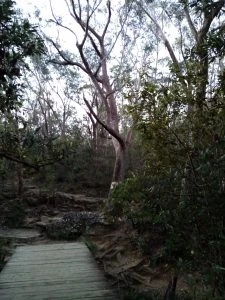Uncategorized
Tips For Your NZ Road Trip Holiday: the South Island
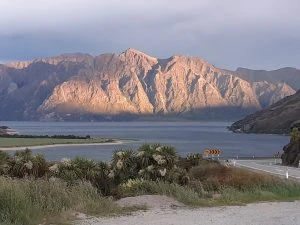
Having just last week raved about some great road trips to take in the North Island of New Zealand, we can’t forget the South Island, can we? For many, the South Island has some of the best spectacular scenery that this small country has to offer in a country that is situated in the Pacific Ocean, a little more isolated than you might first have thought (yes, even more than Australia – Australia doesn’t often get left off world maps). The South Island is situated at just about the bottom of the world and is full of mountains, rivers, and lakes, and home to some of the best sea creatures, sea views, and birdlife you’ll see anywhere on the planet – well, that’s my opinion.
One of the best ways to see the South Island, if you want to do a one-off hit, is to fly directly into Queenstown. Despite barely qualifying as a city, Queenstown is an international airport and so takes a lot of direct flights to and from the main Australian centres. If you want to add a South Island trip to a North Island trip as well, then the Cook Strait is an easy sea connection between the two main islands. Ferries run the route between Picton and Wellington daily, so these are an easy way to bridge the gap between the islands (book first). Simply drive onto the boat at one end and drive off at the other.
The South Island was known as “Te Waipounamu” by the early Māori, which means “the waters of greenstone”. That’s a more creative name than the boring colonial one, and it gives a nod to just how much beautiful greenstone can be found around this expansive land, full of remote and wild areas. Greenstone is mainly found throughout Westland’s alluvial glacial moraines. The main historical Māori gathering places for greenstone are between Greymouth and Hokitika. Now that’s super convenient because you can start your South Island adventure from either Queenstown or Picton, and drive the length of the West Coast of the South Island, taking your time to thoroughly immerse yourself in the fun laid-back town of Hokitika, capture the glorious Alpine views with Mt Cook and Mt Tasman topping the height charts, and settle yourself down on the beach at Greymouth eating fish and chips as you watch the sun sink down below the horizon, westward across the sea. Don’t forget to have a look at Punakaiki!
Townships on the West Coast are rather spread out, so if you notice your fuel tank or EV battery charge getting on the low side, top up when you can to avoid getting caught out.
If there is any case for choosing an SUV-style vehicle to rent in New Zealand, then the South Island probably merits renting a vehicle like a Mitsubishi Outlander or Toyota RAV4 more than the North Island does. This is because the South Island has some stunning roads that you can explore – remote roads like the ski pass roads to Otago Central’s best ski fields, and other roads with gravel surfaces, like the corrugated route up the Matukituki Valley near Wanaka, where you can be astounded by Mt Aspiring’s immense size and steep slopes. Spend a night or two in Mount Cook National Park and be wowed by the McKenzie Basin’s star-gazing potential and beautiful blue glacial lakes. Soak in a hot tub at Omarama and go mountain biking or ice skating at Tekapo. There is so much to do!
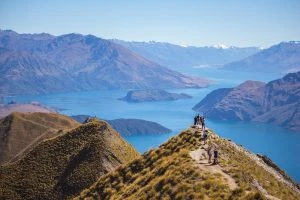
New Zealand might be a lot smaller than Australia, but the mountains certainly aren’t. So be prepared for some hill driving, especially if you plan on crossing some of the passes on your road trip. The Lewis Pass is the gentlest of the three.
Do take a trip south of Queenstown. Te Anau is a great place to encounter some of New Zealand’s rarest native birds. You can also cruise across Lake Te Anau and go into the mysterious glow worm caves. This is a real treat! Of course, if you get this far, take the time to head over to Milford Sound and view the iconic Mitre Peak. A boat will take you out into Milford Sound, where you’ll be stunned by the sheer steepness and bigness of the mountains that rise up out of the sea. There are waterfalls cascading down into the sea all year round.
The drive from Te Anau to Milford is longer than you may expect, and you’ll encounter a lot of tour buses. Also check the road conditions before you set out, as the road can be closed because of the avalanche risk, and the Powers That Be can be jumpy in their efforts to avoid nasty accidents.
Now for another amazing trip that is less talked about! Southland is home to some of the best views of the Takitimu Mountains, green pastures, rolling hills, sea, and lakes. Drive from Te Anau to Manapouri, where you’ll find pretty lake views and stunning lakeside walks. From Manapouri, take the road to Tuatapere, which will take you around the southern end of the Takitimu range. On route you’ll enjoy splendid vistas and views as the road climbs up over Blackmount. Google Maps and the like may send you over a gravel road; if this happens to you and you’ve never driven gravel before, the big thing is to keep your speeds down lower than you think around corners and stay in the ruts.
Keep an eye open for agricultural machinery and trucks in this part of the country, as you’re likely to encounter tractors using the roads a lot, and just about every small dot on the map town has a trucking company and a contractor or three, and they all use the main roads, as do the dairy tankers. At certain times of the year, farmers move cows along public roads.
Do take the coastal route from Tuatapere to Invercargill because the sea views are breathtaking. You can stop at McCracken’s Rest and be wowed – and the bent trees give you an indication of how strong the winds are (take note if you plan on towing a caravan or a campervan with high sides). Take a walk along Riverton’s peaceful beachfront and dip your toes in the cool sea water (but it’s not icy – it was warmer than I expected). Swim if its in the middle of summer (February)! Find out more about Burt Munroe’s stamping ground at the motorcycle museum in Invercargill and take a walk around Queens Park – Invercargill’s gorgeous botanical gardens. Invercargill is a popular spot for petrolheads, with a motorbike museum and a truck museum on offer, and lots of classic car lovers who are happy to talk about their machines.
Lastly, I wanted to share what is a treasure trove of scenic views, surfing, and waterfall walks you’ll enjoy as you take the coastal route around the Catlins, a route that takes you from Invercargill to Fortrose, then up through Owaka to Balclutha. Say hi to some sea lions at Pounawea, and make sure you do the walk out to the Nugget Point Lighthouse (amazing!).
Welcome to the South Island of New Zealand – and that’s just the beginning!
Planning A Kiwi Road Trip? Some of the Best Bits of the North Island
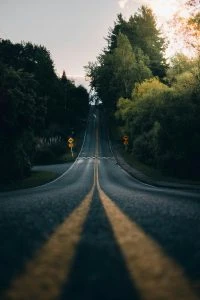
We need to admit that our mates across the ditch have a nice back yard in which they can play, and New Zealand (pronounced “Nuzilin”) isn’t that far away. And it’s a good place for a road trip. There are not too many things which can bite you, or, if they do, you’re unlikely to die from them. So, what does New Zealand have to offer?
Having spent a bit of time in both the North and the South Islands, I’ve come across some spectacular places to go see and experience. The warmer of the two islands is the North, but that doesn’t mean that there won’t be a cool breeze or a bit of rain scampering up from the south every now and then.
An airfare from any major Australian centre doesn’t cost a lot flying into Auckland. Obviously, Sydney to Auckland is usually the cheapest. From here, one of the coolest bits (figuratively – it’s reasonably warm) of the North Island is the narrow expanse of land to the north of New Zealand’s largest city. You will take in some breathtaking coastal views as you journey up through Whangarei up to Kaitaia, and then experience the fun of the white sands along ninety-mile beach, which runs right up to Cape Reinga at the top. Poor Knights Islands are worth a look, and there are plenty of boats that can take you offshore to experience some amazing sights and fishing excursions if you don’t want to stick to the road. Another hidden away gem is the Whangarei Falls, which is easier to drive to.
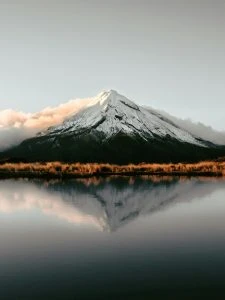
Tongariro National Park
Take in the sights around Lake Taupo as well the magnificent central mountains: Mt Ruapehu, Mt Ngauruhoe, and Mt Tongariro. Tongariro National Park is one of the stunning scenic places to drive in the North Island. You can ski in winter or mountain bike in the summer. There’s always plenty of water sports, fishing, and boat excursions in this area as well. If you’re driving there in winter, be prepared and check the road report, as snow can sometimes close the road.
East Coast
Gisborne is home to some of the best surfing waves and citrus fruit you’ll find anywhere – at least on that side of the Tasman. You can also be the first person in the world to experience the rising of the sun as the new day dawns. Take your time and travel from north to south, coming toward Gisborne either around the East Cape or more directly through Waioeka Gorge. Both options are stunningly gorgeous. If you have a self-contained camper/caravan, there are many lovely places to stop for the night to take in the culture and the scenic beauty.
The roads here can be very winding and steep, and keep an eye out for logging trucks, as there are lots of them buzzing about these roads. Although larger wildlife getting on the road isn’t as common as it is over here (they don’t have kangaroos), the roads around the East Coast can be prone to goats.
West Coast
Less known about but equally as amazing are the secluded beaches along the west coast of the North Island. One amazing trip would be heading from Auckland down through the King Country to Tihiroa, then turn westward and go out to the coast, where you’ll enjoy some amazing scenery, stunning land formations, and Kawhia Hot Water Beach. Yes, you can make a pool on the beach and soak in some geothermally heated water. Head further south and experience the amazing Waitomo Caves, then go and grab yourself some fish and chips in New Plymouth. Mount Taranaki (Mt Egmont) is the stunning backdrop to the east, and the beautiful blue ocean is to the west, so you can eat your fish and chips as you watch the sun sink low into the ocean. Taranaki also boasts some of the best surfing beaches.
I haven’t even mentioned the Taihape to Napier, route with its red tussock slopes and steep rugged hills. This will really put your hill driving skills to the test. Yes, there’s lots to see. Next time I’ll have to mention some of the great South Island road trips.
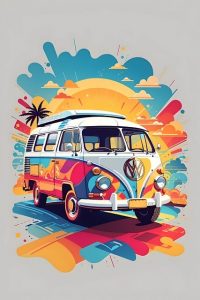
I Locked My Keys Inside The Car!
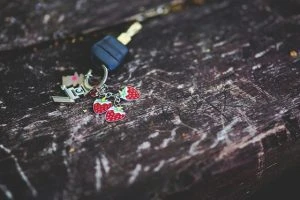
According to the Royal Automobile Association of South Australia Inc (RAA), there are plenty of reasons why motorists reach out for roadside help or assistance. The obvious reasons might be having a flat battery, the car not starting, or just plain running out of fuel (or battery charge). But there is one other quite common reason for requiring roadside assistance from an experienced technician and that is you’ve locked the keys in the car! For me – and I can vouch from experience – this is the reason that tops the list of the most embarrassing reasons for a call-out.
If you make a habit of leaving the keys in the car as a fairly common occurrence, one thing that might make life a little less stressful is to hide an extra key somewhere on the outside of the vehicle’s body. You can buy a little magnetic box that’s big enough to accommodate a spare car key for the car, though not so huge you’ll be drawing a load of attention to it. For obvious reasons, it’s probably best not to have the box painted pink or some other bright colour either. The great thing about these boxes is that they can stick themselves magnetically to any metal surface which is part of the vehicle’s bodywork. One excellent area would be the vehicle’s underbody framework.
Once you’ve put the spare key inside, find yourself a great location on the bodywork in an obscure and hard to reach location. Obviously, you want it to be in a place where the wee box won’t easily be knocked off or be seen. Making it a bit difficult for yourself to reach is better than having it attached in a place where thieves can easily find it.
Fortunately, on the one hand, many of the new cars we buy come with electronic door opening mechanisms known as electronic keys or digital keys. Not so fortunately, on the other hand, there is a big downside to having these digital keys if you lose the gadget (key fob), because, as my mother has found out, it can take days to find it or cost hundreds of dollars to replace it. You may even need the help of a tow company to have the vehicle towed to a garage or local dealer.
Then there is the fact that if you’ve lost the digital key fob but have a mechanical key for opening the door, you’ll still require the digital key to start the vehicle! In this situation, and if you’re lucky enough to own the right new vehicle, the vehicle may have an override starting switch. You just need to know where its located, and that information might be in the manufacturer’s manual back at home (which is why I keep the manual in the glovebox or one of the cabin storage compartments).
There are some vehicles that have door locks that are recessed inside the interior door handle. These will likely require the help of a professional to open. But, if you have an older vehicle which has the raised lock pins on the doors on the topside of the window ledge, then these can be unlocked fairly easily with a sturdy bit of wire. If you have a bit of know-how and mechanical aptitude, then this can be a DIY job.
At any rate, if possible do make sure you do have a spare mechanical key or a spare digital key fob that you know where it is – on the car or at home. This makes the event of locking yourself out of a vehicle that much easier to deal with.
Some new cars can be unlocked via a smartphone app. This is even easier than the hidden key trick. However, if your phone is inside the car along with the keys (it happens), then you’ve really got a problem, as you can’t call for roadside assistance or a locksmith either.
More tips:
- Train yourself to check the keys before you get in or out of the car. If you have a keyless stop/start function, clip that key to your belt loops or keep it in your pocket.
- If you’re unsure who to call and you’re not part of a roadside assistance scheme, then call the non-urgent police number, not 999. The number is 131 444.
- Keep a spare in your handbag or wallet if you don’t like the idea of storing one on the car itself.
Scenic Routes: Taking A Moment To Look Around When Driving
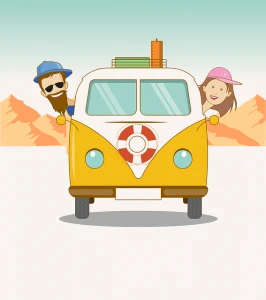
Recently, we flew into Sydney and had need to spend a few days to catch up with family. As we were staying in northern Sydney for a few days, we had some time between gatherings to get out and about and enjoy the sights. One of the days, we had to drive from Glenhaven up to the Hunter Valley, which is situated well north of Sydney towards Newcastle (as some of you know if you happen to live there). Wow, the Hunter Valley is a stunning place showcasing some stunning skyscapes and rolling hills around Cessnock.
Before we set off to our northern destination, we dialled up the best route with no tolls to pay on Google Maps. To our delight, we were sent on a beautiful drive through Galston Gorge. Except for a brief excursion into the Blue Mountains, up to this point we had only been travelling within Sydney itself and had little experience of any roads travelled less by the general public. This little beauty, which only kept us off the Pacific Motorway for 45 minutes or so, took us through an amazing forest with a few narrow bridges that had us skipping over steep ravines with little streams well below. Some of the turns in the road had to be taken at 5 km/h, such was the sharpness of the change in angle and the steep terrain. What a magical experience, and all of this just moments from Sydney’s urban hustle.
Another special part of the trip involved our brief look at the Blue Mountains National Park, where we travelled on the main route through Bullaburra and out to Wentworth Falls. Here we went for a decently lengthy couple of walks, one of which had us being awed by the beauty of the natural waterfalls. Some other great views of the Blue Mountains occurred as we were coming back on the homeward journey towards Sydney just as the sun was setting in all of its golden glory, carpeting the Blue Mountain forest canopy in a glowing yellow.
It got me to thinking of how easily some of those special moments are easily missed in the business of life. We could have chosen to stay in Sydney’s confines rather than take the trip south, and these adventures confirmed to me how I need to keep taking the time to enjoy the beautiful nature that’s around our home base, as well as going a little further afield when I travel somewhere new. Or maybe drive instead of fly, if time permits!
We don’t always have to travel long distances in our cars to find a magical experience in nature, where the birds are happily singing, the waterfall or river is still bubbling, and we can again discover that there isn’t that much wrong with the world after all – at least out here. Even inside our boxes of glass and steel with all the climate control, ambient lighting and connectivity, perhaps its time that we rediscovered what’s outside the bubble for a little bit. Take the scenic route, whether it’s suggested by Google Maps or not. Open the windows and smell the bush. Switch off the music and hear the crows and cockatoos squawking and screeching. If you’re the passenger, put the device down and indulge in an old-fashioned game of I Spy.
